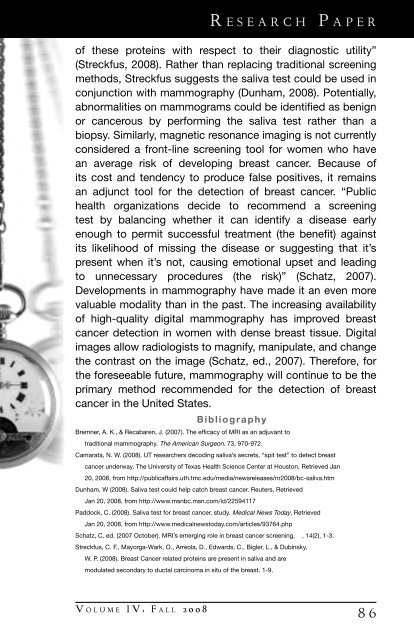2008 - Communication Across the Curriculum (CAC)
2008 - Communication Across the Curriculum (CAC)
2008 - Communication Across the Curriculum (CAC)
You also want an ePaper? Increase the reach of your titles
YUMPU automatically turns print PDFs into web optimized ePapers that Google loves.
R e s e a r c h P a p e r<br />
of <strong>the</strong>se proteins with respect to <strong>the</strong>ir diagnostic utility”<br />
(Streckfus, <strong>2008</strong>). Ra<strong>the</strong>r than replacing traditional screening<br />
methods, Streckfus suggests <strong>the</strong> saliva test could be used in<br />
conjunction with mammography (Dunham, <strong>2008</strong>). Potentially,<br />
abnormalities on mammograms could be identified as benign<br />
or cancerous by performing <strong>the</strong> saliva test ra<strong>the</strong>r than a<br />
biopsy. Similarly, magnetic resonance imaging is not currently<br />
considered a front-line screening tool for women who have<br />
an average risk of developing breast cancer. Because of<br />
its cost and tendency to produce false positives, it remains<br />
an adjunct tool for <strong>the</strong> detection of breast cancer. “Public<br />
health organizations decide to recommend a screening<br />
test by balancing whe<strong>the</strong>r it can identify a disease early<br />
enough to permit successful treatment (<strong>the</strong> benefit) against<br />
its likelihood of missing <strong>the</strong> disease or suggesting that it’s<br />
present when it’s not, causing emotional upset and leading<br />
to unnecessary procedures (<strong>the</strong> risk)” (Schatz, 2007).<br />
Developments in mammography have made it an even more<br />
valuable modality than in <strong>the</strong> past. The increasing availability<br />
of high-quality digital mammography has improved breast<br />
cancer detection in women with dense breast tissue. Digital<br />
images allow radiologists to magnify, manipulate, and change<br />
<strong>the</strong> contrast on <strong>the</strong> image (Schatz, ed., 2007). Therefore, for<br />
<strong>the</strong> foreseeable future, mammography will continue to be <strong>the</strong><br />
primary method recommended for <strong>the</strong> detection of breast<br />
cancer in <strong>the</strong> United States.<br />
Bibliography<br />
Bremner, A. K., & Recabaren, J. (2007). The efficacy of MRI as an adjuvant to<br />
traditional mammography. The American Surgeon. 73, 970-972.<br />
Camarata, N. W. (<strong>2008</strong>). UT researchers decoding saliva’s secrets, “spit test” to detect breast<br />
cancer underway. The University of Texas Health Science Center at Houston, Retrieved Jan<br />
20, <strong>2008</strong>, from http://publicaffairs.uth.tmc.edu/media/newsreleases/nr<strong>2008</strong>/bc-saliva.htm<br />
Dunham, W (<strong>2008</strong>). Saliva test could help catch breast cancer. Reuters, Retrieved<br />
Jan 20, <strong>2008</strong>, from http://www.msnbc.msn.com/id/22594117<br />
Paddock, C. (<strong>2008</strong>). Saliva test for breast cancer, study. Medical News Today, Retrieved<br />
Jan 20, <strong>2008</strong>, from http://www.medicalnewstoday.com/articles/93764.php<br />
Schatz, C, ed. (2007 October). MRI’s emerging role in breast cancer screening. , 14(2), 1-3.<br />
Streckfus, C. F., Mayorga-Wark, O., Arreola, D., Edwards, C., Bigler, L., & Dubinsky,<br />
W. P. (<strong>2008</strong>). Breast Cancer related proteins are present in saliva and are<br />
modulated secondary to ductal carcinoma in situ of <strong>the</strong> breast. 1-9.<br />
V o l u m e I V : F a l l 2 0 0 8<br />
8 6






